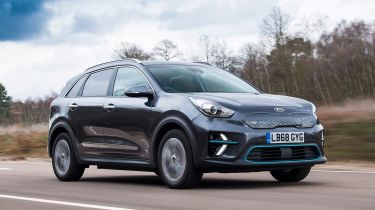Kia e-Niro (2017-2022) review - Engines, performance and drive
The e-Niro is good to drive, striking a useful balance between range and performance

The Kia e-Niro is a great car to drive: comfortable and refined but with warm-hatch levels of performance and neat – if not terribly exciting – handling. The car is nicely set up, its suspension working well despite the increased weight of the batteries over the hybrid versions. Bumps are ably soaked up, while body control is really good for a heavy SUV.
There’s lots of grip through corners, but it’s easy to overcome the car’s traction when accelerating from low speeds with the electric motor’s dump of low-down torque spinning the wheels before the traction control realises what’s happening. Driving with smooth pedal inputs helps avoid this (and will prolong the life of the front tyres).
Drivers are likely to be most taken aback by the e-Niro’s remarkable performance – there’s loads of punch even at motorway speeds, with the hefty 395Nm of torque instantly available with a prod of the throttle at any speed. It’s easy to keep pace with traffic, join motorways safely and perform swift overtakes.
There are three driving modes on offer: Eco, Comfort and Sport. The latter tightens up throttle response and adds some weight to the steering. With this mode selected, it’s feasible to have fun on a B-road, where the e-Niro’s acceleration out of corners never gets old.
Perhaps more helpful in and around town is the decent level of brake regeneration. The driver is able to adjust the settings via steering wheel-mounted paddles - moving between level 0 which delivers free-wheel coasting, up to level 4's strong levels of deceleration allowing for one-pedal driving.
Engines, 0-60 acceleration and top speed
The Kia e-Niro is powered by a single electric motor with either 134bhp or 201bhp; both are quick off the mark with 0-62mph taking 9.5s and 7.5s, respectively.
Kia offers either a 39kWh or 64kWh battery for the e-Niro, which is the same powertrain set-up as the Kona Electric; both are market-leading, offering a better balance between range and performance than the BMW i3 or Nissan Leaf.
Top speed is not entirely relevant in an electric car – the e-Niro 64kWh model has a 104mph maximum, but running this speed on a derestricted autobahn would see the battery drain very quickly.









